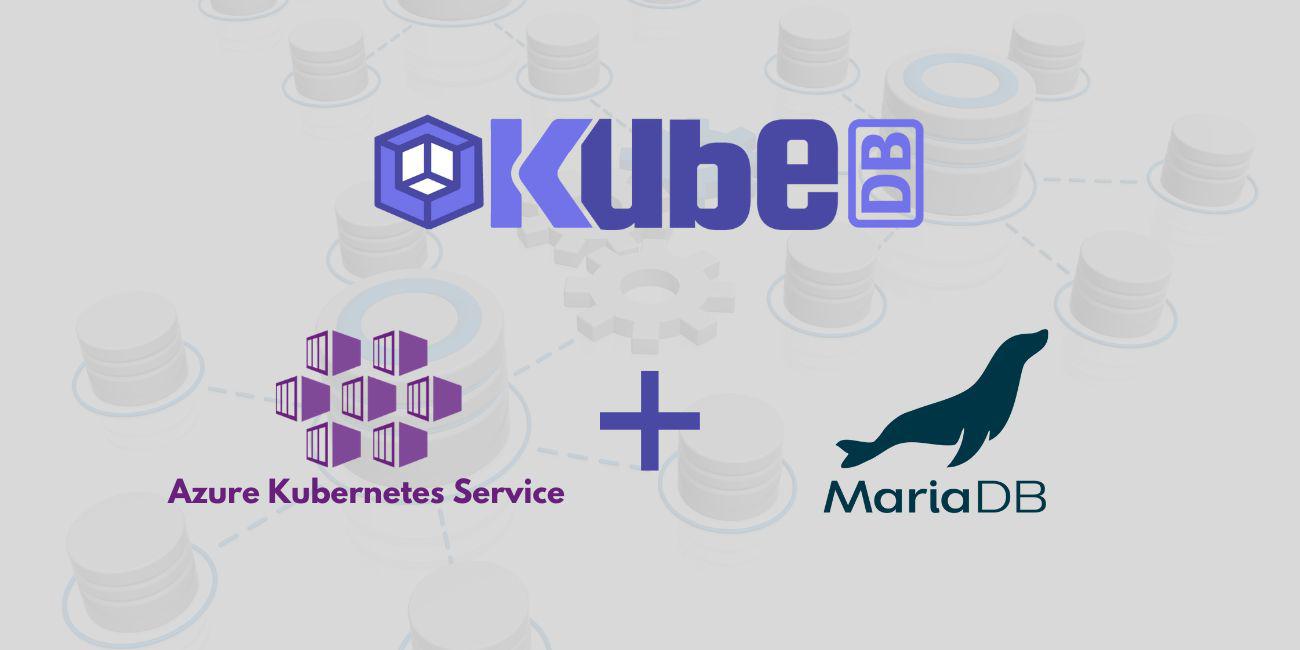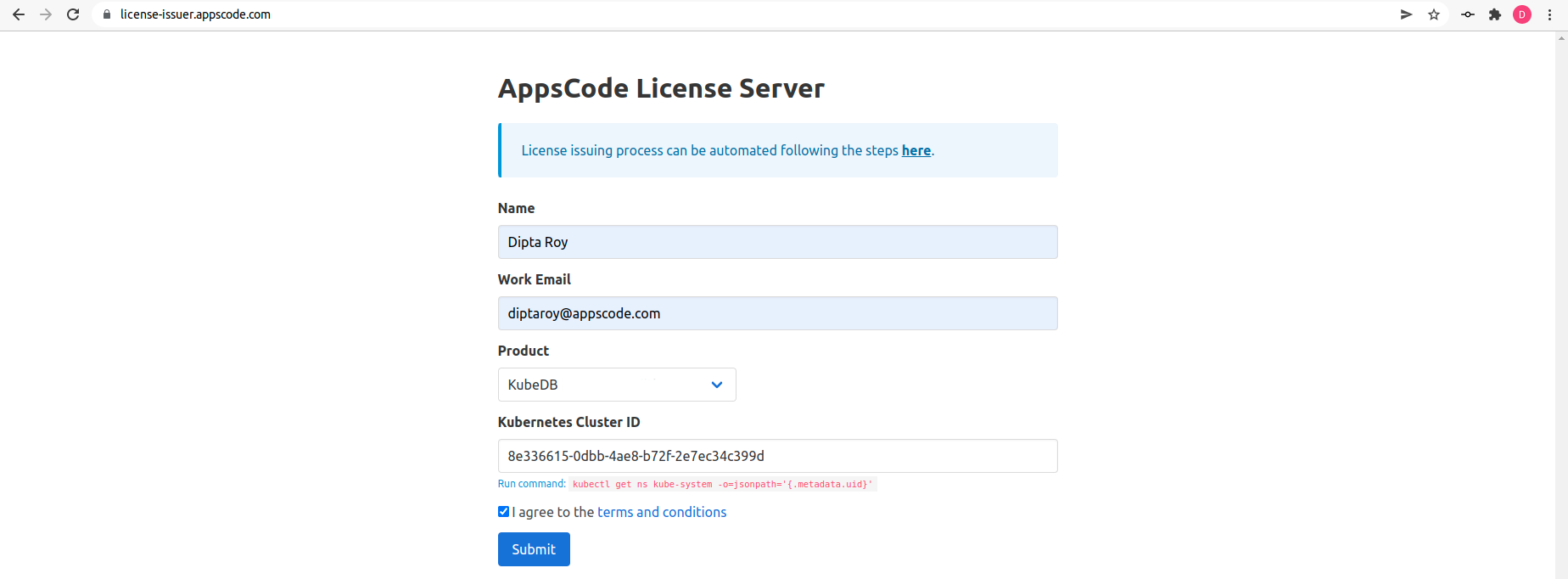
Overview
KubeDB is the Kubernetes Native Database Management Solution which simplifies and automates routine database tasks such as Provisioning, Monitoring, Upgrading, Patching, Scaling, Volume Expansion, Backup, Recovery, Failure detection, and Repair for various popular databases on private and public clouds. The databases supported by KubeDB include MongoDB, Elasticsearch, MySQL, MariaDB, Redis, PostgreSQL, Percona XtraDB, and Memcached. Additionally, KubeDB also supports ProxySQL, PgBouncer, and the streaming platform Kafka. You can find the guides to all the supported databases in KubeDB . MariaDB Galera Cluster is a virtually synchronous multi-master cluster for MariaDB. The Server replicates a transaction at commit time by broadcasting the write set associated with the transaction to every node in the cluster. The client connects directly to the DBMS and experiences behavior that is similar to native MariaDB in most cases. The wsrep API (write set replication API) defines the interface between Galera replication and MariaDB. In this tutorial we will deploy MariaDB Galera Cluster in Azure Kubernetes Service (AKS). We will cover the following steps:
- Install KubeDB
- Deploy MariaDB Galera Cluster
- Read/Write Sample Data
Get Cluster ID
We need the cluster ID to get the KubeDB License. To get cluster ID we can run the following command:
$ kubectl get ns kube-system -o jsonpath='{.metadata.uid}'
8e336615-0dbb-4ae8-b72f-2e7ec34c399d
Get License
Go to Appscode License Server to get the license.txt file. For this tutorial we will use KubeDB.

Install KubeDB
We will use helm to install KubeDB. Please install helm here
if it is not already installed.
Now, let’s install KubeDB.
$ helm search repo appscode/kubedb
NAME CHART VERSION APP VERSION DESCRIPTION
appscode/kubedb v2023.12.28 v2023.12.28 KubeDB by AppsCode - Production ready databases...
appscode/kubedb-autoscaler v0.25.0 v0.25.0 KubeDB Autoscaler by AppsCode - Autoscale KubeD...
appscode/kubedb-catalog v2023.12.28 v2023.12.28 KubeDB Catalog by AppsCode - Catalog for databa...
appscode/kubedb-community v0.24.2 v0.24.2 KubeDB Community by AppsCode - Community featur...
appscode/kubedb-crds v2023.12.28 v2023.12.28 KubeDB Custom Resource Definitions
appscode/kubedb-dashboard v0.16.0 v0.16.0 KubeDB Dashboard by AppsCode
appscode/kubedb-enterprise v0.11.2 v0.11.2 KubeDB Enterprise by AppsCode - Enterprise feat...
appscode/kubedb-grafana-dashboards v2023.12.28 v2023.12.28 A Helm chart for kubedb-grafana-dashboards by A...
appscode/kubedb-kubestash-catalog v2023.12.28 v2023.12.28 KubeStash Catalog by AppsCode - Catalog of Kube...
appscode/kubedb-metrics v2023.12.28 v2023.12.28 KubeDB State Metrics
appscode/kubedb-one v2023.12.28 v2023.12.28 KubeDB and Stash by AppsCode - Production ready...
appscode/kubedb-ops-manager v0.27.0 v0.27.0 KubeDB Ops Manager by AppsCode - Enterprise fea...
appscode/kubedb-opscenter v2023.12.28 v2023.12.28 KubeDB Opscenter by AppsCode
appscode/kubedb-provider-aws v2023.12.28 v0.2.0 A Helm chart for KubeDB AWS Provider for Crossp...
appscode/kubedb-provider-azure v2023.12.28 v0.2.0 A Helm chart for KubeDB Azure Provider for Cros...
appscode/kubedb-provider-gcp v2023.12.28 v0.2.0 A Helm chart for KubeDB GCP Provider for Crossp...
appscode/kubedb-provisioner v0.40.0 v0.40.0 KubeDB Provisioner by AppsCode - Community feat...
appscode/kubedb-schema-manager v0.16.0 v0.16.0 KubeDB Schema Manager by AppsCode
appscode/kubedb-ui v2023.12.20 0.6.1 A Helm chart for Kubernetes
appscode/kubedb-ui-server v2021.12.21 v2021.12.21 A Helm chart for kubedb-ui-server by AppsCode
appscode/kubedb-webhook-server v0.16.0 v0.16.0 KubeDB Webhook Server by AppsCode
$ helm install kubedb oci://ghcr.io/appscode-charts/kubedb \
--version v2023.12.28 \
--namespace kubedb --create-namespace \
--set-file global.license=/path/to/the/license.txt \
--wait --burst-limit=10000 --debug
Let’s verify the installation:
$ watch kubectl get pods --all-namespaces -l "app.kubernetes.io/instance=kubedb"
NAMESPACE NAME READY STATUS RESTARTS AGE
kubedb kubedb-kubedb-autoscaler-58d9c78d74-2h9ml 1/1 Running 0 3m54s
kubedb kubedb-kubedb-dashboard-9d45fdc88-6fbnm 1/1 Running 0 3m54s
kubedb kubedb-kubedb-ops-manager-59b75cb5b-p8rcv 1/1 Running 0 3m54s
kubedb kubedb-kubedb-provisioner-54568fcf99-lhch8 1/1 Running 0 3m54s
kubedb kubedb-kubedb-webhook-server-7c869d7b9f-bvbkd 1/1 Running 0 3m54s
We can list the CRD Groups that have been registered by the operator by running the following command:
$ kubectl get crd -l app.kubernetes.io/name=kubedb
NAME CREATED AT
elasticsearchautoscalers.autoscaling.kubedb.com 2024-01-26T05:39:44Z
elasticsearchdashboards.dashboard.kubedb.com 2024-01-26T05:40:44Z
elasticsearches.kubedb.com 2024-01-26T05:40:44Z
elasticsearchopsrequests.ops.kubedb.com 2024-01-26T05:40:57Z
elasticsearchversions.catalog.kubedb.com 2024-01-26T05:38:34Z
etcds.kubedb.com 2024-01-26T05:40:57Z
etcdversions.catalog.kubedb.com 2024-01-26T05:38:35Z
kafkaopsrequests.ops.kubedb.com 2024-01-26T05:41:57Z
kafkas.kubedb.com 2024-01-26T05:41:10Z
kafkaversions.catalog.kubedb.com 2024-01-26T05:38:35Z
mariadbautoscalers.autoscaling.kubedb.com 2024-01-26T05:40:44Z
mariadbopsrequests.ops.kubedb.com 2024-01-26T05:41:34Z
mariadbs.kubedb.com 2024-01-26T05:40:58Z
mariadbversions.catalog.kubedb.com 2024-01-26T05:38:35Z
memcacheds.kubedb.com 2024-01-26T05:40:59Z
memcachedversions.catalog.kubedb.com 2024-01-26T05:38:36Z
mongodbarchivers.archiver.kubedb.com 2024-01-26T05:41:13Z
mongodbautoscalers.autoscaling.kubedb.com 2024-01-26T05:40:45Z
mongodbopsrequests.ops.kubedb.com 2024-01-26T05:41:02Z
mongodbs.kubedb.com 2024-01-26T05:41:00Z
mongodbversions.catalog.kubedb.com 2024-01-26T05:38:36Z
mysqlarchivers.archiver.kubedb.com 2024-01-26T05:41:15Z
mysqlautoscalers.autoscaling.kubedb.com 2024-01-26T05:40:46Z
mysqlopsrequests.ops.kubedb.com 2024-01-26T05:41:31Z
mysqls.kubedb.com 2024-01-26T05:41:03Z
mysqlversions.catalog.kubedb.com 2024-01-26T05:38:36Z
perconaxtradbautoscalers.autoscaling.kubedb.com 2024-01-26T05:40:46Z
perconaxtradbopsrequests.ops.kubedb.com 2024-01-26T05:41:49Z
perconaxtradbs.kubedb.com 2024-01-26T05:41:04Z
perconaxtradbversions.catalog.kubedb.com 2024-01-26T05:38:36Z
pgbouncers.kubedb.com 2024-01-26T05:41:05Z
pgbouncerversions.catalog.kubedb.com 2024-01-26T05:38:37Z
postgresarchivers.archiver.kubedb.com 2024-01-26T05:41:17Z
postgresautoscalers.autoscaling.kubedb.com 2024-01-26T05:40:46Z
postgreses.kubedb.com 2024-01-26T05:41:06Z
postgresopsrequests.ops.kubedb.com 2024-01-26T05:41:42Z
postgresversions.catalog.kubedb.com 2024-01-26T05:38:37Z
proxysqlautoscalers.autoscaling.kubedb.com 2024-01-26T05:40:47Z
proxysqlopsrequests.ops.kubedb.com 2024-01-26T05:41:45Z
proxysqls.kubedb.com 2024-01-26T05:41:07Z
proxysqlversions.catalog.kubedb.com 2024-01-26T05:38:38Z
publishers.postgres.kubedb.com 2024-01-26T05:42:00Z
redisautoscalers.autoscaling.kubedb.com 2024-01-26T05:40:48Z
redises.kubedb.com 2024-01-26T05:41:08Z
redisopsrequests.ops.kubedb.com 2024-01-26T05:41:37Z
redissentinelautoscalers.autoscaling.kubedb.com 2024-01-26T05:40:48Z
redissentinelopsrequests.ops.kubedb.com 2024-01-26T05:41:52Z
redissentinels.kubedb.com 2024-01-26T05:41:09Z
redisversions.catalog.kubedb.com 2024-01-26T05:38:38Z
subscribers.postgres.kubedb.com 2024-01-26T05:42:03Z
Deploy MariaDB Galera Cluster
Now, we are going to Deploy MariaDB using KubeDB. First, let’s create a Namespace in which we will deploy the database.
$ kubectl create namespace demo
namespace/demo created
Here is the yaml of the MariaDB CRO we are going to use:
apiVersion: kubedb.com/v1alpha2
kind: MariaDB
metadata:
name: galera-cluster
namespace: demo
spec:
version: "11.2.2"
replicas: 3
storageType: Durable
storage:
storageClassName: "default"
accessModes:
- ReadWriteOnce
resources:
requests:
storage: 1Gi
terminationPolicy: WipeOut
Let’s save this yaml configuration into galera-cluster.yaml
Then create the above MariaDB CRO
$ kubectl apply -f galera-cluster.yaml
mariadb.kubedb.com/galera-cluster created
In this yaml,
spec.versionfield specifies the version of MariaDB Here, we are using MariaDBversion 11.2.2. You can list the KubeDB supported versions of MariaDB by running$ kubectl get mariadbversioncommand.spec.storagespecifies PVC spec that will be dynamically allocated to store data for this database. This storage spec will be passed to the StatefulSet created by KubeDB operator to run database pods. You can specify any StorageClass available in your cluster with appropriate resource requests.- And the
spec.terminationPolicyfield is Wipeout means that the database will be deleted without restrictions. It can also be “Halt”, “Delete” and “DoNotTerminate”. Learn More about Termination Policy .
Once these are handled correctly and the MariaDB object is deployed, you will see that the following objects are created:
$ kubectl get all -n demo
NAME READY STATUS RESTARTS AGE
pod/galera-cluster-0 2/2 Running 0 2m56s
pod/galera-cluster-1 2/2 Running 0 2m56s
pod/galera-cluster-2 2/2 Running 0 2m55s
NAME TYPE CLUSTER-IP EXTERNAL-IP PORT(S) AGE
service/galera-cluster ClusterIP 10.76.5.4 <none> 3306/TCP 2m57s
service/galera-cluster-pods ClusterIP None <none> 3306/TCP 2m57s
NAME READY AGE
statefulset.apps/galera-cluster 3/3 2m57s
NAME TYPE VERSION AGE
appbinding.appcatalog.appscode.com/galera-cluster kubedb.com/mariadb 11.2.2 2m58s
NAME VERSION STATUS AGE
mariadb.kubedb.com/galera-cluster 11.2.2 Ready 3m1s
Let’s check if the database is ready to use,
$ kubectl get mariadb -n demo galera-cluster
NAME VERSION STATUS AGE
galera-cluster 11.2.2 Ready 3m22s
We have successfully deployed MariaDB Galera Cluster in AKS. Now we can exec into the container to use the database.
Accessing Database Through CLI
To access the database through CLI, we have to get the credentials to access.
KubeDB will create Secret and Service for the database galera-cluster that we have deployed. Let’s check them using the following commands,
$ kubectl get secret -n demo -l=app.kubernetes.io/instance=galera-cluster
NAME TYPE DATA AGE
galera-cluster-auth kubernetes.io/basic-auth 2 3m58s
$ kubectl get service -n demo -l=app.kubernetes.io/instance=galera-cluster
NAME TYPE CLUSTER-IP EXTERNAL-IP PORT(S) AGE
galera-cluster ClusterIP 10.76.5.4 <none> 3306/TCP 4m14s
galera-cluster-pods ClusterIP None <none> 3306/TCP 4m14s
Now, we are going to use galera-cluster-auth to get the credentials.
$ kubectl get secrets -n demo galera-cluster-auth -o jsonpath='{.data.username}' | base64 -d
root
$ kubectl get secrets -n demo galera-cluster-auth -o jsonpath='{.data.password}' | base64 -d
qMTNlxhj*wM~Q1n7
Data Availability
In a MariaDB Galera Cluster, Each member can read and write. Now, we will insert data from any of the available nodes, and we will see whether we can get the data from every other members.
Insert Sample Data
In this section, we are going to login into our MariaDB database pod and insert some sample data.
$ kubectl exec -it galera-cluster-0 -n demo -c mariadb -- bash
mysql@galera-cluster-0:/$ mariadb --user=root --password='qMTNlxhj*wM~Q1n7'
Welcome to the MariaDB monitor. Commands end with ; or \g.
Copyright (c) 2000, 2018, Oracle, MariaDB Corporation Ab and others.
Type 'help;' or '\h' for help. Type '\c' to clear the current input statement.
MariaDB [(none)]> CREATE DATABASE Music;
Query OK, 1 row affected (0.015 sec)
MariaDB [(none)]> CREATE TABLE Music.Artist (id INT(6) UNSIGNED AUTO_INCREMENT PRIMARY KEY, Name VARCHAR(50), Song VARCHAR(50));
Query OK, 0 rows affected (0.014 sec)
MariaDB [(none)]> INSERT INTO Music.Artist (Name, Song) VALUES ("John Denver", "Country Roads");
Query OK, 1 row affected (0.004 sec)
MariaDB [(none)]> SELECT * FROM Music.Artist;
+----+-------------+---------------+
| id | Name | Song |
+----+-------------+---------------+
| 1 | John Denver | Country Roads |
+----+-------------+---------------+
1 row in set (0.001 sec)
MariaDB [(none)]> exit
Bye
...
$ kubectl exec -it galera-cluster-1 -n demo -c mariadb -- bash
mysql@galera-cluster-1:/$ mariadb --user=root --password='qMTNlxhj*wM~Q1n7'
Welcome to the MariaDB monitor. Commands end with ; or \g.
Copyright (c) 2000, 2018, Oracle, MariaDB Corporation Ab and others.
Type 'help;' or '\h' for help. Type '\c' to clear the current input statement.
# Read data from Node 2
MariaDB [(none)]> SELECT * FROM Music.Artist;
+----+-------------+---------------+
| id | Name | Song |
+----+-------------+---------------+
| 1 | John Denver | Country Roads |
+----+-------------+---------------+
1 row in set (0.001 sec)
MariaDB [(none)]> exit
Bye
...
$ kubectl exec -it galera-cluster-2 -n demo -c mariadb -- bash
root@galera-cluster-2:/# mariadb --user=root --password='qMTNlxhj*wM~Q1n7'
Welcome to the MariaDB monitor. Commands end with ; or \g.
Copyright (c) 2000, 2018, Oracle, MariaDB Corporation Ab and others.
Type 'help;' or '\h' for help. Type '\c' to clear the current input statement.
# Insert data from Node 3
MariaDB [(none)]> INSERT INTO Music.Artist (Name, Song) VALUES ("Avicii", "The Nights");
Query OK, 1 row affected (0.004 sec)
# Read data from Node 3
MariaDB [(none)]> SELECT * FROM Music.Artist;
+----+-------------+---------------+
| id | Name | Song |
+----+-------------+---------------+
| 1 | John Denver | Country Roads |
| 2 | Avicii | The Nights |
+----+-------------+---------------+
2 rows in set (0.001 sec)
MariaDB [(none)]> exit
Bye
We’ve successfully inserted some sample data to our database. Also, access it from every node of galera cluster. More information about Run & Manage Production-Grade MariaDB Database on Kubernetes can be found in MariaDB Kubernetes
If you want to learn more about Production-Grade MariaDB on Kubernetes you can have a look into that playlist below:
Support
To speak with us, please leave a message on our website .
To receive product announcements, follow us on Twitter/X .
To watch tutorials of various Production-Grade Kubernetes Tools Subscribe our YouTube channel.
More about MariaDB on Kubernetes
If you have found a bug with KubeDB or want to request for new features, please file an issue .










